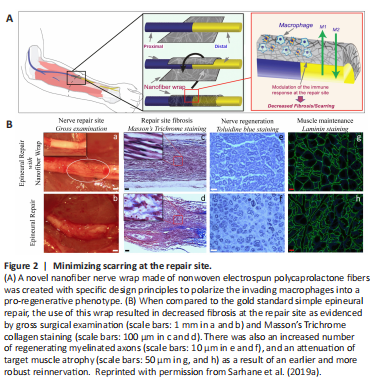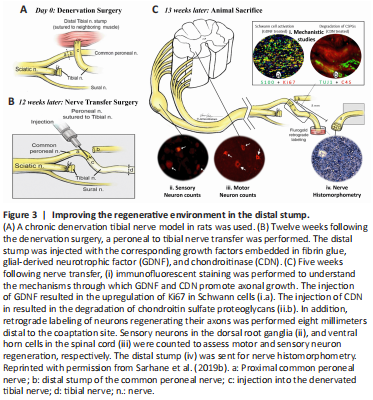周围神经损伤
-
Figure 2|Minimizing scarring at the repair site.

In this regard, modalities that decrease scarring at the repair site are needed, as they carry the potential to increase the number of axons crossing the repair site and hence improve muscle reinnervation. Such modalities will have to address the complex “scarring” phenomenon, which involves an interplay of numerous cell types. One way to regulate this interplay is by providing specific biochemical cues to the key cells directing the inflammatory cascade. The purpose of such cues is to stimulate the inflammatory cells to secrete factors that create a pro-regenerative environment (instead of secreting factors that promote scarring). Many cell types are involved in the nerve injury healing cascade. Macrophages play a central role in tissue repair and remodeling. They secrete cytokines that directly affect the tissue response to injury (Fujiwara and Kobayashi, 2005). Some biomaterials can be designed to provide specific micro-environmental signals that polarize the invading macrophages into a regenerative phenotype (Adutler-Lieber et al., 2014). In a previous study, we took advantage of this feature and applied it to nerve regeneration. We created a nanofiber nerve wrap made of nonwoven electrospun PCL fibers with specific design principles (Fiber diameter 1.1 ± 0.5 μm and pore size 6 ± 2 μm, both post-heat treatment) to modify the phenotype of macrophages. We showed that when applied to the coaptation site in a sciatic nerve cut and repair model in rats, the wrap modulated the immune response by polarizing the invading macrophages into a pro-regenerative anti-inflammatory M2 phenotype (Figure 2A). Those M2 macrophages secreted anti-inflammatory factors that altered the cytokine milieu, resulting in decreased scarring at the nerve repair site (Figure 2B-a–d), enhanced axonal regeneration and myelination (Figure 2B-e and f), and decreased target muscle atrophy (Figure 2B-g and h) (Sarhane et al., 2019a).
Figure 3|Improving the regenerative environment in the distal stump.

In this regard, supplementation of the chronically denervated distal stump with exogenous growth factors is a versatile therapeutic strategy to restore its growth-supportive potential and facilitate axonal growth. Sulaiman’s group used a chronic denervation and axotomy rat model and demonstrated that transforming growth factor-β1 alone and with forskolin reversed the deleterious effect of chronic SC denervation and reactivated them to support axonal regeneration (Sulaiman and Gordon, 2002; Sulaiman and Dreesen, 2014; Sulaiman et al., 2018). However, the simple addition of growth factors to the distal stump, although somehow effective in animal models, might not translate to human applications due to the short half?life and rapid degradation of growth factors in bodily fluids (growth factors are small peptides that get denatured and digested when in contact with human enzymes). To overcome these shortcomings, our group incorporated growth factors into a biodegradable fibrin-based inert biomaterial for a sustained local delivery (Figure 3A, and B). This system was first optimized in vitro and then tested in vivo in a chronic denervation animal model. We showed that it provided the SCs in the distal stump with a constant amount of GDNF (over 4 days) resulting in their re-activation (Figure 3C-ia). It also supplemented the distal stump with chondroitinase resulting in the degradation of the inhibitory chondroitin sulfate proteoglycans (Figure 3C-ib). Both the number of regenerating sensory and motor neurons (Figure 3C-ii, iii), and the degree of axonal myelination were improved (Figure 3C-iv), by 5.8 and 3.7 times respectively. Our sacrifice endpoint was however not long enough for the regenerating axons to reach their target muscle to assess functional outcomes (Sarhane et al., 2019b). A modality that releases growth factors for a more prolonged period would be more clinically attractive.